|
|
|
| |
Ibike
Korea People-to-People Program
|
| |
|
| |
|
| |
|
 Photo essay:
Pallang to Yeoju via Geumsa Photo essay:
Pallang to Yeoju via Geumsa
|
| |
|
Pallang to Geumsa (40mi, 20km) Generally hilly.
Points of Interest: farmland, river valleys, small towns. |
| |
 |
The Pallang Dam was built
in 1960, primarily for flood control. But it also served to blocked river
boat commerce. This was a time when roads into the interior were poor or
non-existent. The dam caused a changed to the economies of the village
economies along the river in the interior. Many of the "ports" along the
river were flood and others have virtually disappear from inactivity. At
Pallang you have the choice of following the west and south river bank (the following
description) or the east and north river bank on the
Hangang Trail.to Yeoju |
| |
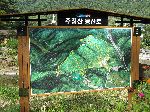 |
Signs like this start to
be regular roadside features soon after you leave urban Seoul. The show
hiking trails in the area. Around Seoul, many of them are accessible by
bus. In more remote areas many are still accessible by bus because of the
countries extensive bus system, but often there is a parking area near-by --
almost always with a few vehicles parked at it. |
| |
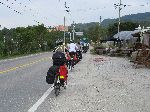 |
Beyond Seoul's urban
footprint most of the flat land is rural agricultural and any land with much of
a slope is forested. Every now and again we came to a cluster of business,
often near a
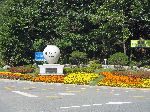 junction
or a small town. The roads are in excellent
conditions and generally have paved shoulders. junction
or a small town. The roads are in excellent
conditions and generally have paved shoulders.Out in the country side it was
not unusual to find elaborate landscaping at a junction pointing to a small
hamlet or neighborhood. The one to the right is for Geumsa-ri. |
| |
 |
"So-tae," wooden birds on
poles. Traditionally these marked the boundaries of a village and were for good
luck. Contemporarily the are used more as decorative art, as they are here. I saw these in a
couple locations. |
| |
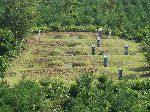 |
One thing that breaks the
forest on the hills is family burial sites. They are distinguished by
their terraces, mounded earth (the grave) and flat, thick stone tables for
offerings. It is a tradition to maintain the grave site at Chusok (several
weeks earlier) so most of the mini-cemeteries were well manicured as we passed. |
| |
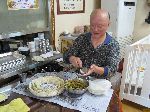 |
Our lunch stop was a
family-run mandu (dumpling) restaurant. The mandu was being hand-made on
the premises by 'grandpa'. |
| |
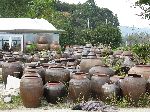 |
Onggi: Traditional thick
stoneware pots used for storing grains, kimchi, soy sauce and bean paste. There
are glazed and unglazed versions. The glaze is made from ash. It is very common
to see these outside of houses, sometimes half buried for additional temperature
control. |
| |
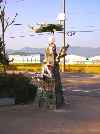 |
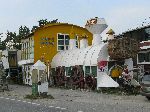
 This
section has a plethora of gallery and small museums along it. Many feature
modern architecture, and have elegant ceramics, fine
painting and / or crafts executed by masters, but the establishment that was a
magnet for pictures was packed
with bright, playful, quirky sculptures and decorations,
including buildings dressed to look like a train engine and an old railroad car
decorated with flowers. This
section has a plethora of gallery and small museums along it. Many feature
modern architecture, and have elegant ceramics, fine
painting and / or crafts executed by masters, but the establishment that was a
magnet for pictures was packed
with bright, playful, quirky sculptures and decorations,
including buildings dressed to look like a train engine and an old railroad car
decorated with flowers.
 Other
objects looked like they were inspired by science-fiction aliens or the
desire to communicate with extraterrestrial beings. Other
objects looked like they were inspired by science-fiction aliens or the
desire to communicate with extraterrestrial beings. |
| |
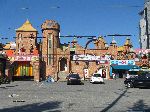 |
The architecture of rural
motels, that cater almost exclusively to Koreans, has a trend that is
interesting. It might be described as a cross between the most un-Korean
French Provincial and Queen Anne styles. Each building is unique so it is
hard to generalize but it is common to find a mixture of arches and square
doors, steep, high, hipped roofs, balconies, towers, and vertical windows,
coquettish detailing and eclectic materials. The desired result seems to be to
create an adventurous and romantic atmosphere. So how and when was this
symbolism implanted into Korean cultural associations? |
| |
|
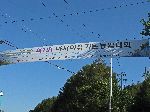 The
is a banner for the "First Asian Organic Rice Conference", Sept 30 - Oct 1,
2011. It is connected with the 17th International Federation of Organic
Agricultural Movements (IFOAM) Conference that was being held in Namyangju,
across the river. Anecdotally it would seem that Koreans prioritize
blemish-free produce over organic, but this might be changing.. The
is a banner for the "First Asian Organic Rice Conference", Sept 30 - Oct 1,
2011. It is connected with the 17th International Federation of Organic
Agricultural Movements (IFOAM) Conference that was being held in Namyangju,
across the river. Anecdotally it would seem that Koreans prioritize
blemish-free produce over organic, but this might be changing.. |
| |
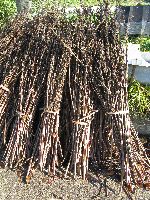 |
For miles, we passed stalks of perilla (wild sesame) leaning on the
guardrails and spread along the shoulder drying. The looked like they had
already dropped most of their seeds so they may have been curing for storage to
be used later as animal feed.
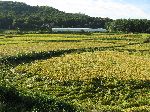
The
is so many lovely rice fields along the route that you feel obliged to stop
periodically and take a picture in the hope that this time you will capture the
tranquility, grace and beauty. It is harder that it looks and rarely
happens.
Right before Yeosu is the entrance to the very interesting
Royal Tombs at Yeongneung. |
| |
 |
 One
of the first sections of the National Bikeway was built in Yeosu in 2011. It
hugs the south bank of the river through town. In the middle of Yeoju the
riverside trail ends and there is a pig tail viaduct which brings users to
street level and into town. The National Bikeway system continues south on
sidewalks and there is a bridge across the river which gives access to rural
roads that can also be used to head south and east. One
of the first sections of the National Bikeway was built in Yeosu in 2011. It
hugs the south bank of the river through town. In the middle of Yeoju the
riverside trail ends and there is a pig tail viaduct which brings users to
street level and into town. The National Bikeway system continues south on
sidewalks and there is a bridge across the river which gives access to rural
roads that can also be used to head south and east. |
|
|
|
| |
Yangsu

 Chungju Chungju |
|



 |
 |
|
|
 Please
contact us if you would like to be added to
Ibike's mailing list or have questions, comments, corrections or criticism. (Also, please let us know how you learned about us and
found this site.) Privacy policy. Please
contact us if you would like to be added to
Ibike's mailing list or have questions, comments, corrections or criticism. (Also, please let us know how you learned about us and
found this site.) Privacy policy.
 IBF Homepage
IBF Homepage  Ibike Programs
Ibike Programs
 Ibike Schedule
Ibike Schedule
 Search
Search
"Hosted by
DreamHost - earth friendly web hosting"
Created by David Mozer
Copyright ?1993-2018 Ibike LLC. All rights reserved.
|
 Photo essay:
Pallang to Yeoju via Geumsa
Photo essay:
Pallang to Yeoju via Geumsa


 junction
or a small town. The roads are in excellent
conditions and generally have paved shoulders.
junction
or a small town. The roads are in excellent
conditions and generally have paved shoulders.





 This
section has a plethora of gallery and small museums along it. Many feature
modern architecture, and have elegant ceramics, fine
painting and / or crafts executed by masters, but the establishment that was a
magnet for pictures was packed
with bright, playful, quirky sculptures and decorations,
including buildings dressed to look like a train engine and an old railroad car
decorated with flowers.
This
section has a plethora of gallery and small museums along it. Many feature
modern architecture, and have elegant ceramics, fine
painting and / or crafts executed by masters, but the establishment that was a
magnet for pictures was packed
with bright, playful, quirky sculptures and decorations,
including buildings dressed to look like a train engine and an old railroad car
decorated with flowers.


 The
is a banner for the "First Asian Organic Rice Conference", Sept 30 - Oct 1,
2011. It is connected with the 17th International Federation of Organic
Agricultural Movements (IFOAM) Conference that was being held in Namyangju,
across the river. Anecdotally it would seem that Koreans prioritize
blemish-free produce over organic, but this might be changing..
The
is a banner for the "First Asian Organic Rice Conference", Sept 30 - Oct 1,
2011. It is connected with the 17th International Federation of Organic
Agricultural Movements (IFOAM) Conference that was being held in Namyangju,
across the river. Anecdotally it would seem that Koreans prioritize
blemish-free produce over organic, but this might be changing..


 One
of the first sections of the National Bikeway was built in Yeosu in 2011. It
hugs the south bank of the river through town. In the middle of Yeoju the
riverside trail ends and there is a pig tail viaduct which brings users to
street level and into town. The National Bikeway system continues south on
sidewalks and there is a bridge across the river which gives access to rural
roads that can also be used to head south and east.
One
of the first sections of the National Bikeway was built in Yeosu in 2011. It
hugs the south bank of the river through town. In the middle of Yeoju the
riverside trail ends and there is a pig tail viaduct which brings users to
street level and into town. The National Bikeway system continues south on
sidewalks and there is a bridge across the river which gives access to rural
roads that can also be used to head south and east. Please
contact us if you would like to be added to
Ibike's mailing list or have questions, comments, corrections or criticism. (Also, please let us know how you learned about us and
found this site.) Privacy policy.
Please
contact us if you would like to be added to
Ibike's mailing list or have questions, comments, corrections or criticism. (Also, please let us know how you learned about us and
found this site.) Privacy policy.![]() IBF Homepage
IBF Homepage ![]() Ibike Programs
Ibike Programs
![]() Ibike Schedule
Ibike Schedule
![]() Search
Search


